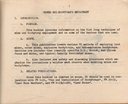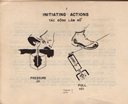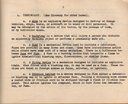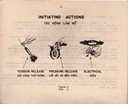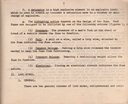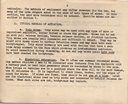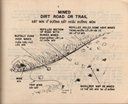|
3rd Battalion Royal Australian Regiment
Your FaithfullyJapan - Korea - Malaya - Borneo - Vietnam - East Timor - Solomons - Iraq - Afghanistan |
| AUSTRALIAN INFANTRY WEAPONS VIETNAM 1971 |
|---|
| SLR |
 |
The standard weapon of the infantry soldier in Vietnam, the SLR (self loading rifle). The L1A1 is the Australian version of the Belgian FN FAL rifle. It entered service with the Australian Army in 1959. Considered a reliable, hard-hitting, gas-operated, magazine-fed semi-automatic rifle, with a maximum battle range of 300 meters and a practical rate of fire of 20 rpm. Ammunition used was a 7.62mm long round. With a full 20 round magazine it weighed 4.96Kg. |
| M16 Armalite |
 |
| M60 |
 |
The 7.62mm M60 general purpose machine-gun (GPMG) American produced weapon came into service with the Australian Army in 1960 and became the main fire power of infantry our sections. The weapon was used as shown (in the bipod configuration) giving an effective range of 500 meters however in Vietnam it was rarely required for that distance. It was used on a tripod and as protective armament on vehicles and helicopters. Gas operated, air cooled and belt fed, with a quick-change barrel to counter overheating during sustained firing, it has a practical rate of fire of 200 rpm. The M60 weighs 10.5 kg, which increases by 6.8kg if a tripod is added, which is why we didn't carry the tripod base. |
| M16 Over & Under |
 |
The combination M16A1 automatic rifle and M203 ( a version of the M79) grenade launcher was produced to avoid the problem of a infantryman having to carry a grenade launcher as well as a weapon for personal protection. The 5.56mm M16A1 is a gas operated, magazine-fed rifle capable of semi-automatic and automatic fire with an effective range of 300 meters and a practical rate of fire of 60 rpm. The M79 40mm grenade launcher was used to provide additional fire support for the infantry section by delivering high explosive, parachute flares and canister rounds . The high explosive had a maximum range of 400 meters and a casualty radius of 5 meters. The M16 Under and Over was used extensively by SAS troops. |
| M79 Grenade Launcher |
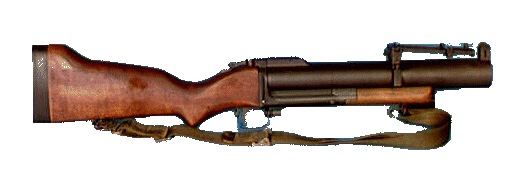 |
| MINES |
| (The most loathsome weapon in any war) |
| A November 1965 manual of Mines and booby traps used by the Viet Cong in South Vietnam. |
| VIETCONG WEAPONS |
| AK 47 |
.gif) |
The AK-47 was the basic infantry weapon of the North Vietnamese Army (NVA) and the Vietcong (VC). Originally manufactured by the Soviet Union, most the the rifles that were used in the war were made in the People's Republic of China, which was the major supplier of armaments to NVA and VC forces. Also known as the Kalishnikov, after its Russian inventor, this weapon was sturdy, reliable, compact, and relatively lightweight. It fired a 7.62mm short round. Could be fired either in a single shot configuration or in a fully automatic mode. Most armaments analysts judge the AK-47, which normally holds thirty rounds, to be superior to the U.S. M-16, which became the standard weapon of American, Korean, and South Vietnamese troops. It was more durable and less adversely affected by the climate and conditions of Vietnam. There are a number of accounts of cases in which American troops preferred to use the AK-47 and in fact did use it when combat conditions permitted. The AK-47 had a distinctive popping sound. |
| RPG |
 |
| The RPG-7 (CHICOM Type-69) is a muzzle loaded, shoulder fired antitank grenade launcher. The VC and NVA used the RPG7V, a Soviet produced short-range, anti-Armour, rocket-propelled grenade, from 1967 against armoured vehicles, defensive positions, personnel and even helicopters. This smoothbore, recoilless weapon consists of a launcher tube fitted with a simple iron sight or a more sophisticated telescopic range-finding sight, and a HEAT rocket grenade projectile with a calibre of 40mm. The RPG-7 has an effective range of 300 meters against moving targets and up to 500 meters against stationary targets. The projectile explodes either on impact or at its maximum range of 920 meters. |
| MA 18 Claymore Mines |
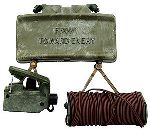 |
| The M18A1 Claymore is a directional anti-personnel mine used by the U.S. military. It was named after the large Scottish sword by its inventor, Norman A. MacLeod. The Claymore fires shrapnel, in the form of steel balls, out to about 100 meters across a 60° arc in front of the device. It is used primarily in ambushes and as an anti-infiltration device against enemy infantry. It is also of some use against soft-skinned vehicles. |
| For a comprehensive list of weapons of the Vietnam War go to http://www.173rdairborne.com/weapons.htm#RPD7 |
 |
| The 3 RAR Internet site gratefully acknowledges the assistance of 101 design of Wollongong. www.101design.com.au |

